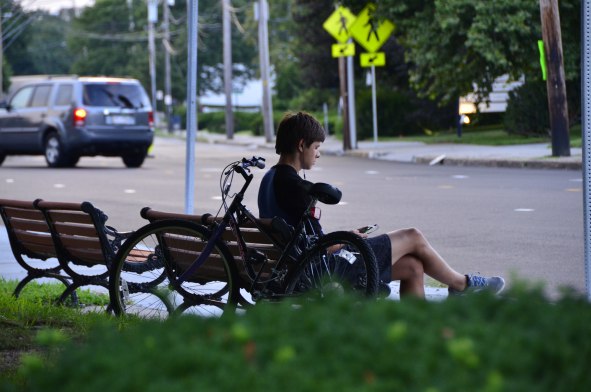
Although cyclists come in all shapes and sizes, those who ride in traffic are a rare breed. On average, their personalities are a combination of courage, optimism about safety, and dedication to a mode of transportation. For some, this dedication is part of an alternative way of life.
When I say alternative, I’m not speaking about something utterly out of the mainstream. Many cyclists live ordinary lives in all ways but in their chosen form of transportation. Yet, this one choice sets them apart from the masses, the motorized transportation majority, and makes them a subject of speculation.
Those who fear riding in traffic perceive those who do as a little crazy. They imagine road cyclists as risk-takers, although most road cyclists don’t see themselves that way. As was said earlier, they have a greater sense of optimism about road safety than people who are afraid to ride in traffic.
This optimism can carry over into other parts of a cyclist’s life, as can the laid-back pace of traveling without a motor. Cyclists vary in how fast they ride, either by choice or by fitness level. Stronger cyclists find it easier to accelerate and to climb hills than do less fit cyclists, but this doesn’t stop the latter from mounting their bikes and riding at a slower pace. Not everyone in American society is in a hurry all of the time.
Bicycles allow one to slow down and to unwind from the stresses of modern life. This isn’t to say that there aren’t times when a cyclist is in a hurry and finds him or herself pumping away furiously at their bike’s pedals trying to go as fast as they can.
Increasing speed on a bicycle is more of an effort than in motorized transportation, but it allows the traveler to feel the increase in speed and the corresponding decrease in time that it will take to arrive at the planned destination. In other words, a cyclist can literally feel himself — his body — going through space faster, and conversely, when decreasing speed, can feel himself slowing down into a more mellow state.
Movement, for cyclists, matches how their bodies feel at any given time and dictates their corresponding frame of mind. So, bicycles can be used to create a frame of mind or set a mood.
Different types of cycling provide examples of the moods that go along with the activity of bicycling. Racing, recreational riding, commuting, and general transport are all different types of bicycle use, with different frames of mind.
Racing is obviously about competition, going faster then everyone else in a field of riders and winning. It’s about victory.
Recreational riding is about fun. It can include fitness riding, but often refers to leisurely riding alone or with friends or family.
Commuting is about alternative transportation to work. It can be engaged in to avoid traffic congestion, to increase fitness, for personal satisfaction or for financial reasons. In any event, it’s about getting too and from work, so it’s serious business.
Riding for general transport can mean many things to many people. Some people just enjoy riding bikes and would rather travel places using this method. Other people live in dense urban environments where owning a car doesn’t make sense. Parking can be a motivator, since car parking is often scare, while bicycle parking is usually plentiful. And, of course, financial reasons can factor in; traveling by bike is less expensive than traveling by car and can make someone living on a tight budget more mobile.
From all of these moods and bicycle uses comes an opportunity to create one’s own environment. The more a rider likes cycling, the more often he or she will use a bike. Pleasure develops from wanting to ride to enjoying taking one’s bike along with them, to have there — just in case. After all, you never know when you might want to hop onto your bike, on the spur of the moment, and head someplace you hadn’t planned to go.
That’s what the young man in the photo above reminds me of. I spotted him sitting peacefully on a public bench entranced, ostensibly, by music playing on his iPod.
Behind the bench, his bike leaned precariously, looking as if it was ready to roll at any moment. He sat motionless for a long time, barely moving a hand to change the settings on his iPod.
His facial expression connoted nothing short of nirvana. He was in a place of unreserved bliss, delight and peace. His face was unutterably calm. His torso was relaxed with one leg draped comfortably over the other. He was oblivious to the world around him for he had created his own world — a world comprised of a young man, a bicycle and an iPod.
I would like to know what brought the young man to that spot, why he stopped his bike and sat down on a bench. Was he coming from somewhere and taking a rest? Or was he beginning a journey and not yet ready to go?
Friends I was waiting for arrived before I could observe the young man’s intentions. Regardless of what his goals were, I will always remember the cycling nirvana he created in the middle of a busy urban square, with cars, bikes and pedestrians zooming all around him. Perhaps his frame of mind was proof that cycling can change one’s attitude, one’s demeanor, and to a greater or lesser degree, one’s quality of life.
[Note: Please leave comments on the new blog.]



